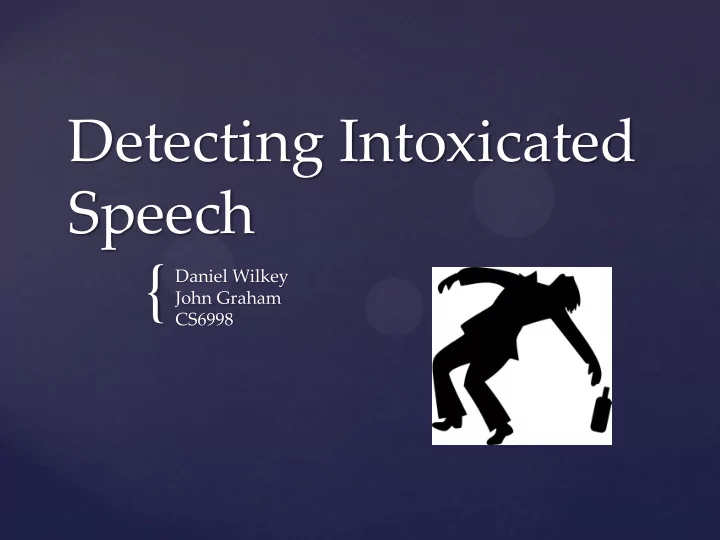

Detecting Intoxicated Speech { Daniel Wilkey John Graham CS6998
Given speech, was the speaker intoxicated? Interspeech 2011 Intoxication Challenge Application for field sobriety testing, ignition-guards Background
ALC – Alcohol Language Corpus 162 total participants: 84 male, 78 female Participants reached a BAC .28 – 1.75 Read 15 minutes of intoxicated speech Returned 2 weeks later Read 30 minutes of sober speech The Corpus
5400 samples in total, 75 per person Divided into 3 sets: Development, Training, Test Development & Training are labeled with 4368 features Used cross validation to obtain results The Corpus p2
Shrikanth Narayanan of UCLA Global speaker normalization Normalizing by the sober class Relative improvement of 7.04% overall Professor Hirchberg Phonotactic and phonetic cues Experiment tests un- weighted average recall… why? We chose f-measure Includes recall and precision Prior Research
Remove extraneous features with WEKA Info-gain ratio algorithm MFCC features performed well No F0-based features near the top Experiment Preparation
Ignore test set unlabeled Down-sampling the training set Achieved 50/50 ratio of alcoholised to non- alcoholised speech Experiment Preparation
Global Speaker Normalization (Narayanan) Insignificant negative change Sober class normalization (Narayanan) Insignificant negative change Gender class normalization Insignificant positive change Combining global speaker with gender normalization 10.75% relative improvement in f-measure Poor performance potentially related to some F0 features being filtered out Normalization Attempts
Tried retesting data with fringe cases omitted Fringe case BAC between .08% and .16% proposed by Batliner We tried .02% to .08% Difference in data set and threshold Relative decrease of F-measure by 3.25% On the Fringe
Machine Learning Optimizations
Varied polynomial kernels Radial basis function (RBF) Optimizing the SVM
Varying number Folds Iterations Optimization Techniques
Configuration SVM kernel n=3 10-fold cross validation Gender normaliation Sober class normalization Difficult to compare!! Final Results
Difficult to compare results Need better corpus Extend with GMM super-vectors Conclusions / Extensions
Recommend
More recommend